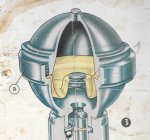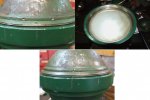OK, here's a revision of my first concept.
The only addition I may consider is to make the end pieces of the cradle able to clamp the sphere in position, say by the larger one having the full 360 deg hole and the smaller one with a clamping bar.
The cradle itself can be clamped or bolted to the bed of the press, or such large object as is needed.
Otherwise I've taken into account the comments so far.
Let me know what we all reckon please.
Cheers, Pottsy
Maybe, use a material thicker than 4mm to give you more surface area to grip with. If you are going to turn the inside, you might as well make it wider and cut a step. That will also help position the clamps more positively.
Are you going to add a gusset to the cradle uprights to stop them bending?
If you are using a press to move it, do you plan to move it a few degrees, unclamp one clamp, move it around to position for the next press stroke and reclamp before pressing a few more degrees? Or am I misunderstanding the proposal?
Another way might be a ring gear and pinion if you want mechanical advantage without using a length of water pipe. If the ring gear is wider than the pinion, you can clamp it together once and accommodate the unscrewing of the two halves. You could possibly do the same with a worm drive, but to keep it in mesh it would probably need to act on the 'driven' clamp via some pegs.
Last edited:



